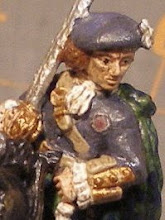After an almost three month absence, I'm finally back to make a few posts. Things around Col Campbell's Barracks have been at a low wintery slump since preparations were completed for my participation in the Colonial Barracks convention back in early November. Since then I haven't done much in the way of hobby activities. But here's where I'm headed.
To the Strongest
My wargaming buddy, Lord Sterling, ordered this set of rules from
BigRedBat. Back in December we played several games using this interesting set of ancient/medieval rules. All of the activation, weapons fire, and combat is controlled by playing cards drawn from a shuffled deck. The card driven activation mechanism sure makes you think about what you want to accomplish and how to sequence events to make that happen. Here are some pictures at various times in the game between two fairly well balanced Roman/Greek/Gallic forces - basically a "civil war" scenario of Romans with Greek and Gallic allies on both sides.
 |
| Two Roman units occupying one of the "terrain" squares during the game. |
The game uses squares to control movement, weapons ranges, and combat during the game. Most infantry can move one or two squares straight forward or diagonally.
 |
| Here's a bigger look at part of the Roman line of battle. We used Lord Sterling's vintage 15mm Roman/Greek/Gallic armies. All of the units were grouped onto movement sabots. |
 |
| Gallic chariots attack some slingers and light archers, doing quick work of them, if I remember correctly. The numbered squares denote the combat strength of each unit. |
 |
| Fight over a farmstead between the defending light archers and an attacking Gallic warband. |
 |
| One flank of the opposing armies, with Gallic warbands mixing it up with Roman troops. |
After the games were over, I was sure that I had found a way to use my ca 1100 AD 15mm medieval figures that I had remounted from DBx standards to Vis Belllica standards - 80mm x 40mm bases with varying numbers of figures on each base. Since they were mounted on Litko bases, I didn't want to go through the machinations of unbasing them to go back to DBx standards.
So now to figure out which size squares to use. The rules suggest using a size that can accommodate two regular size uits per square with room left for a mounted commander. Since I have 80mm x 40mm bases that meant the smallest square size would be 4" x 4" (ca 100mm square). So I drew out two squares and tested some bases on them:
 |
| Each 4" square (red outline) holds two regular units, here two cavalry on left versus two infantry on right. |
 |
| With the mounted commanders thrown in, things get kind of tight. |
I really didn't like the tightness of the 4" squares, especially when it makes it difficult to fit mounted commanders into the squares without them partially sitting on top of the unit bases.
OK, let's use 5" squares:
 |
| With the 5" squares (black outline), the units don't look so crowded. |
 |
| And the 5" squares even give more room for the mounted commanders. |
So it looks like I'll be using 5" squares. And when I want to use my ca 1200-1300 25mm medieval figures, 5" squares will just about work for them:
 |
| Two 25mm cavalry units on the left face off against two 25mm infantry units on right. All figures are individually based and then mounted on magnetic movement stands with either 3 cavalry or 6 infantry figures per stand. |
I've also read that Simon of Big Red Bat is contemplating expanding the rules into the Renaissance, Thirty Years War, and English Civil War periods. Using 5" squares will also accommodate my vintage MiniFig 15mm ECW armies:
 |
| On left are two different size cavalry units, with a mounted commander, facing off against one large infantry unit, with a mounted commander. |
 |
| Here the two cavalry units have been equalized (5 stands each) and are opposing the same infantry unit in a different formation plus a galloper gun and a mounted commander. |
 |
| Reducing the cavalry units to four stands each really doesn't change the geometry much. |
Now all I have to do is mark up some old battlefield cloths to distinguish the corners of the 5" squares and my 15mm Normanno-Italian, Papal Italian, and Byzantine armies can contest once again for southern Italy.































































